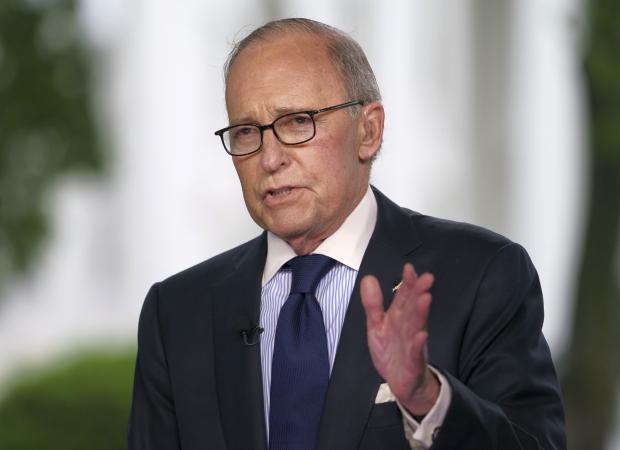Economic talks between US and China lead to trade war truce

White House chief economic adviser Larry Kudlow speaks during a television interview outside the West Wing of the White House, in Washington, Friday, May 18, 2018. (Photo by CAROLYN KASTER / AP)
WASHINGTON — The United States and China are pulling back from the brink of a trade war after the world’s two biggest economies reported progress in talks aimed at bringing down America’s massive trade deficit with Beijing.
“We are putting the trade war on hold,” Treasury Secretary Steven Mnuchin said Sunday.
After high-level talks Thursday and Friday in Washington, Beijing agreed in a joint statement with the US to “substantially reduce” America’s trade deficit with China, but did not commit to cut the gap by any specific amount. The Trump administration had sought to slash the deficit by $200 billion.
Still, Mnuchin said the two countries had made “meaningful progress” and that the administration has agreed to put on hold proposed tariffs on up to $150 billion in Chinese products. China had promised to retaliate in a move that threatened a tit for tat trade war.
He said they expect to see a big increase – 35 to 45 percent this year alone – in US farm sales to China. Mnuchin also forecast a doubling in sales of US energy products to the Chinese market, increasing energy exports by $50 billion to $60 billion in the next three years to five years.
Commerce Secretary Wilbur Ross, who has been part of the US negotiating team, will go to China soon to follow up on last week’s discussions, Mnuchin said.
But China’s government said Monday that it cannot guarantee trade tensions with Washington can be permanently avoided.
A foreign ministry spokesman, Lu Kang, said Mnuchin’s comments showed both sides hope to avoid a “trade war.” However, he added, “Given the increasing interaction between the two countries, we cannot assure you they will not encounter more frictions or disputes in the future.”
In a statement Saturday, Beijing committed to “significantly increase” its purchases of American goods and services, saying the increase would “meet the growing consumption needs of the Chinese people and the need for high-quality economic development.”
Last year, the US had a record $376 billion deficit with China in the trade of goods; that was the largest by far with any nation.
Trade analysts were not surprised that China refused to agree to a numerical target for cutting the trade gap, but they said the talks probably were more successful in easing trade tensions.
“The Trump administration seems eager to engineer at minimum a temporary peace with China to ensure a smooth run-up to the Kim-Trump summit in June,” Cornell University economist Eswar Prasad said, referring to the June 12 meeting scheduled between President Donald Trump and North Korean leader Kim Jong Un.
If there is success in the US-China discussions, analysts suggest it likely would involve the countries’ presidents this fall before the November elections.
“Part of the good news for markets: As long as both sides continue to be ’constructively’ engaged, imposition of additional tariffs by either side is very unlikely,” analysts at investment management firm Evercore ISI said in a research note. “There is no reason for either side – particularly the US – to destroy the process that both sides are building, which is what imposing tariffs would do.”
Sen. Lindsey Graham (Republican-South Carolina) praised the administration’s efforts with China.
“It’s smart to engage China on trade abuses, and it would also be smart to get them more involved in trying to help us with North Korea,” Graham said.
Trump campaigned in 2016 on a pledge to get tough on China and other U.S. trading partners. He views the U.S. trade deficit with China as evidence that Beijing is engaged in abusive trading practices and has outmaneuvered previous U.S. administrations.
Last August, US Trade Representative Robert Lighthizer began investigating Beijing’s strong-arm tactics to challenge U.S. technological dominance. These include outright cybertheft of US companies’ trade secrets and China’s demands that American corporations hand over technology in exchange for access to the Chinese markets.
Last month, the administration proposed tariffs on $50 billion of Chinese imports to protest the forced technology transfers. Trump later ordered Lighthizer to seek up to an additional $100 billion in Chinese products to tax.
China responded by targeting $50 billion in US products, including soybeans – a shot at Trump supporters in America’s heartland. The prospect of an escalating trade war has shaken financial markets and alarmed business leaders.
In a separate controversy, the Commerce Department last month blocked China’s ZTE Corp. from importing American components for seven years, accusing the telecommunications company of misleading US regulators after it settled charges last year of violating sanctions against Iran and North Korea.
The ban amounted to a death sentence for ZTE, which relies heavily on US parts, and the company announced that it was halting operations. A week ago, Trump tweeted that he was working with Chinese President Xi Jinping to put ZTE “back in business, fast.” Media reports suggested that the US was offering to swap a ZTE rescue for an end to proposed Chinese tariffs on US farm products.
Sen. Mark Warner of Virginia, the top Democrat on the Senate Intelligence Committee, called Trump’s intervention in the case “outrageous” and said that using ZTE “as a bargaining chip … is not in the best interests of our national security.”
White House economic adviser Larry Kudlow said there could be “some small changes around the edges” in the sanctions against ZTE. But Kudlow added: “Do not expect ZTE to get off scot-free. It ain’t gonna happen.”
Mnuchin and Graham appeared on “Fox News Sunday,” Warner spoke on CNN’s “State of the Union,” and Kudlow was interviewed on ABC’s “This Week.”